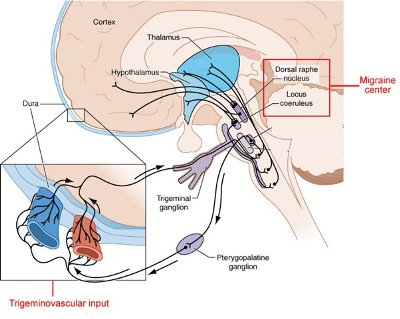Pathophysiology of Migraine
 Migraine is a clinical syndrome of self – limited neurogenic inflammation which is “a referred pain from duramator and blood vessels”. The nerve cells of brain it self are not sensitive to pain producing stimuli, but arteries coursing the membrane covering the brain contain pain – sensitive nerve endings. When these intracranial structures like skin, blood vessel, muscles of neck which become a source of pain. The pathogenesis mechanism could be explained as a neurovascular disorder because its pathology involves important interactions between the cerebral nerves and blood vessels. The vascular theory holds that initial vaso-constriction or shunting of blood through carotid-arterio-venous anastomoses produces cerebral ischemia and starts the attack. The neurogenic theory considers it to be a spreading depression of cortical electrical activity followed by vascular phenomena. The triggering event appears to produce neurogenic inflammation of affected blood vessel wall.
Migraine is a clinical syndrome of self – limited neurogenic inflammation which is “a referred pain from duramator and blood vessels”. The nerve cells of brain it self are not sensitive to pain producing stimuli, but arteries coursing the membrane covering the brain contain pain – sensitive nerve endings. When these intracranial structures like skin, blood vessel, muscles of neck which become a source of pain. The pathogenesis mechanism could be explained as a neurovascular disorder because its pathology involves important interactions between the cerebral nerves and blood vessels. The vascular theory holds that initial vaso-constriction or shunting of blood through carotid-arterio-venous anastomoses produces cerebral ischemia and starts the attack. The neurogenic theory considers it to be a spreading depression of cortical electrical activity followed by vascular phenomena. The triggering event appears to produce neurogenic inflammation of affected blood vessel wall.
Migraines are believed to be a neurovascular disorder with evidence supporting its mechanisms starting within the brain and then spreading to the blood vessels. Some researchers believe neuronal mechanisms play a greater role. While others believe blood vessels play the key role. Others believe both are likely important.
According to Ayurvedic system, the origin of migraine headache is due to the causative factors like Pitta Dosha obstructs the flow of Vata dosha in brain, causing throbbing pain. In case of Suryavarta type of headache, because Pitta is dominant in the afternoon, headache is at peak. The condition calms down by the dusk.
